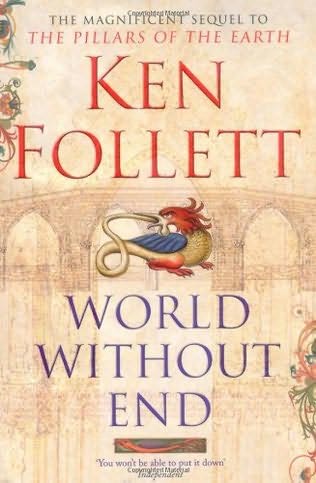
By Stephen O'Shea, Special to The Times
Descendants of the author's Kingsbridge folk in "The Pillars of the Earth" contend with 14th century calamities.
At more than 1,000 pages, Ken Follett's "World Without End" comes perilously close to fulfilling the promise of its title. The second of the thriller writer's medieval novels, this new supersized story inspires the same question posed by its doorstop predecessor: Too fat to pick up, or too engrossing to put down? Naturally the author plumps for the latter: Sure of interest in the project, he invited a crew to film him writing the monster, and the program aired in his native Britain last month.
All this excess will delight the Follett faithful, accustomed to his whipsaw plotting and repeated recourse to violence and rapine. Like his previous medieval effort, "The Pillars of the Earth" (his most popular book to date), "World Without End" makes for giddy chutes-and-ladders reading; no situation can be reversed too often, no conflict resolved without serial surprises. Follett's Middle Ages -- bestial, political, venal -- are relentlessly eventful.
The setting is Kingsbridge, a stout market town in the heart of England whose 12th century cathedral builders were put through the Follett wringer in "Pillars." Now comes the turn of their descendants, as the novel follows four principals through the first half of the calamitous 14th century. Two spirited women -- one a stubborn and lovesick serf, the other a preternaturally intelligent merchant's daughter -- lead tempestuous lives intertwined with those of two sons of a ruined nobleman. One boy becomes a master architect; the other, rotten to the core, rises in the ranks of the aristocracy through the application of strategic atrocity. As children, these four witnessed a murder on which the kingdom's fate hinged; as adults, they struggle for power and position amid the interest groups in the town: monastery, nunnery and merchants' guild.
While the story zigzags mostly around this foursome and their weddings and beddings, along the way Follett has his many characters work out the mechanics of medieval bridge building, wool dyeing, market trading, medicinal bleeding and tax levying. These nuts-and-bolts dialogues are edifying, even if at times the enterprising townspeople sound, alas, like the guileless problem solvers of "The Magic School Bus." Where Follett excels, however, is in the dramatization of the politics of clergymen versus burghers versus nobles -- the constant tug of war that made medieval life as contentious as our age of litigation. Monastic politics, for example, usually come coated with dust in academic histories; here, thanks to Follett's breezy, anachronistic style, the obscure infighting is fresh and diverting. Thus we are treated to the memorable prior of the monastery in Kingsbridge, incompetent at everything save acquiring and maintaining power, and his Karl Rove-like sidekick, adept at playing dirty tricks and sliming reputations. Like the current White House, the two move from one catastrophic decision to the next, all the while maintaining the upper hand.
So, what actually happens? In the first half, the central stake is the governance of Kingsbridge and its revenue-generating fleece fair. The bright merchant's daughter, Caris, and her paramour architect, Merthin, struggle to free the town from monastic control and its hidebound devotion to tradition. Follett shows how effervescent the medieval era was, with trade expanding and new ideas cautiously being floated. The lovers' ambitions are thwarted when Caris, accused of heresy, is forced into a convent, upon which the heartbroken Merthin decamps to seek his fortune in Florence. Unbowed, Caris journeys to France with a beautiful lesbian nun and accidentally witnesses the Battle of Crécy, the kickoff to the Hundred Years' War. Mayhem connoisseurs will rejoice at this reconstruction.
Into the narrative roars the Black Death, reshuffling, or rather halving, the deck and allowing the survivors a chance to hatch new schemes and couple with new partners. It will come as no shock to his readers that Follett, whose flair for nonconsensual-sex scenes borders on the distressing, lingers on the hideous symptoms and agonies of plague victims. In a more seemly vein, he demonstrates how the epidemic changed the lives of peasants, who suddenly had bargaining power as a result of the labor shortage. In the wake of the plague, the perpetually luckless serf Gwenda finally manages to outmaneuver her rapist overlord, who is none other than Merthin's ne'er-do-well brother, Ralph.
In the dizzying spiral of the book's latter half, Caris more or less invents modern medicine in her convent plague hospital in Kingsbridge. Merthin, now a rich widower, returns to town. Ralph, a hero of Crécy and thus in royal favor, extorts, bludgeons and abuses with abandon.Couples are made and unmade, ghastly comeuppances dished out and a swarm of subplots finally put to sleep, until at last a gay bishop and his lover (both French, of course) come to see the innate reasonableness of the townspeople, who are led by Merthin and Caris, united by love and brains.
Stretch plausibility as it may, "World Without End" remains a breathless entertainment, and one with few pretensions to faithfully re-creating the Middle Ages. (That feat was perhaps best achieved in Zoé Oldenbourg's 1946 classic, "The World Is Not Enough.")Serious medievalists may sniff and literary novelists howl, but legions of readers will go along for the ride -- needing nothing more than a strong pair of wrists to lift the darn thing and, if I may make a suggestion, a very big bowl of popcorn.
From: LA TIMES


No comments:
Post a Comment